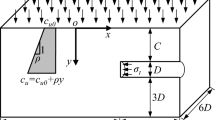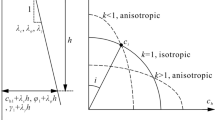Abstract
This paper develops a novel two-dimensional failure mechanism for local stability of tunnel face in \(c - \varphi\) soils. This mechanism is hybrid in which the failure is involved in complex movement. The failure blocks respectively with the translational and rotational movements are introduced. To fulfill the compatibility requirement, the interface between the failure blocks is constructed by employing a spatial discretizing technique. In the framework of upper bound analysis, the energy that dissipates along the discontinuities and within the failure block are fully accounted and the solution of support pressure is derived. Optimization is performed based on the solution to select the optimal mechanism, obtain the support pressure, and identify the failure mode. The proportion of translational block to rotational block is explored. The energy dissipates along the discontinuities are compared to that dissipates within the block. The parametric analysis is performed to explore the influence of soil shear strength on the stability. The result indicates that the frictional angle has more significant influence on the failure mechanism than the cohesion. The failure movements in different patterns identified. The proportion of the failure involved in the rotational movement is reduced significantly with increasing \(\varphi^{\prime}\). For the proposed hybrid mechanism the rotational movement is dominant at low \(\varphi^{\prime}\) and it is replaced by the rotational one at high \(\varphi^{\prime}\). This finding supports previous findings regarding mechanism constructing states; for pure cohesive soils the rotational mechanism works well, whereas, for high frictional soils, the translational mechanism outperforms it. This paper ends with the validation of the current solution by comparing to other analytical solutions and numerical simulation.










Similar content being viewed by others
Data availability statement
The data that support the findings of this study are available from the corresponding authors upon reasonable request.
References
Ahmed M, Iskander M (2012) Evaluation of tunnel face stability by transparent soil models. Tunn Undergr Space Technol 27(1):101–110
Chambon P, Corté J (1994) Shallow tunnels in cohesionless soil: stability of tunnel face. J Geotech Eng 120(7):1148–1165
Chen WF (1975) Limit analysis and soil plasticity. Elsevier, Amsterdam
Chen RP, Li J, Kong LG, Tang LJ (2013) Experimental study on face instability of shield tunnel in sand. Tunn Undergr Space Technol 33(1):12–21
Cheng HZ, Chen J, Chen RP, Chen GL (2019) Reliability study on shield tunnel face using a random limit analysis method in multilayered soils. Tunn Undergr Space Technol 84:353–363
Duncan JM (1996) State of the art: limit equilibrium and finite element analysis of slopes. J Geotech Geoenviron Eng 122(7):577–596
Hou CT, Yang XL (2020) Seismic stability of 3D tunnel face considering tensile strength cut-off. KSCE J Civ Eng 24:2232–2243
Huang MS, Song CX (2013) Upper-bound stability analysis of a plane strain heading in non-homogeneous clay. Tunn Undergr Space Technol 38:213–223
Idinger G, Aklik P, Wu W, Borja R (2011) Centrifuge model test on the face stability of shallow tunnel. Acta Geotech 6(4):105–117
Kirsch A (2010) Experimental investigation of the face stability of shallow tunnels in sand. Acta Geotech 5(1):43–62
Leca E, Dormieux L (1990) Upper bound and lower bound solutions for the face stability of shallow circular tunnels in frictional material. Géotechnique 40(4):581–606
Li Y, Emeriault F, Kastner R, Zhang ZX (2009) Stability analysis of slurry shield-driven tunnel in soft clay. Tunn Undergr Space Technol 24:472–481
Li TZ, Yang XL (2020) Stability of plane strain tunnel headings in soils with tensile strength cut-off. Tunn Undergr Space Technol 95:103138
Liu W, Wu B, Shi PX, Cai GQ (2021) Upper bound analysis of working face passive failure in large-diameter shield tunneling based on a composite mechanism. Comput Geotech 138:104362
Liu W, Wu B, Shi PX, Xu XY (2021) Analysis on face stability of rectangular cross-sectional shield tunneling based on an improved two-dimensional rotational mechanism. Acta Geotech 16(11):3725–3738
Liu W, Zhao Y, Shi PX, Li JY, Gan PL (2018) Face stability analysis of shield-driven tunnels shallowly buried in dry sand using 1-g large-scale model tests. Acta Geotech 13(3):693–705
Lv XL, Wang HR, Huang MS (2014) Upper bound solution for the face stability of shield tunnel below the water table. Math Prob Eng. https://doi.org/10.1155/2014/727964
Lv XL, Zeng S, Zhao YC, Huang MS, Ma SK, Zhang ZG (2020) Physical model tests and discrete element simulation of shield tunnel face stability in anisotropic granular media. Acta Geotech 15(10):3017–3026
Lv XL, Zhou YC, Huang MS, Zeng S (2018) Experimental study of the face stability of shield tunnel in sands under seepage condition. Tunn Undergr Space Technol 74:195–205
Lyamin AV, Sloan SW (2002) Upper bound limit analysis using linear finite elements and non–linear programming. Int J Numer Anal Method Geomech 26:181–216
Ma SK, Duan ZB, Huang Z, Liu Y, Shao Y (2022) Study on the stability of shield tunnel face in clay and clay-gravel stratum through large-scale physical model tests with transparent soil. Tunn Undergr Space Technol 119:104199
Michalowski RL, Drescher A (2009) Three-dimensional stability of slopes and excavations. Geotechnique 59:839–850
Mollon G, Dias D, Soubra A (2010) Face stability analysis of circular tunnels driven by a pressurized shield. Journal Of Geotechnical And Geoenvironmental Engineering 136(1):215–229
Mollon G, Dias D, Soubra A (2011) Rotational failure mechanisms for the face stability analysis of tunnels driven by a pressurized shield. Int J Numer Anal Method Geomech 35(12):1363–1388
Mollon G, Dias D, Soubra A (2013) Continuous velocity fields for collapse and blowout of a pressurized tunnel face in purely cohesive soil. Int J Numer Anal Method Geomech 37:2061–2083
Optum Computational Engineering. (2019) OptumG2, finite element program for geotechnical analysis. Version 2019, www.optumce.com.
Pan QJ, Dias D (2017) Safety factor assessment of a tunnel face reinforcement by horizontal dowels. Eng Struct 142:56–66
Pan QJ, Dias D (2018) Three dimensional face stability of a tunnel in weak rock masses subjected to seepage forces. Tunn Undergr Space Technol 2018:555–566
Di Prisco C, Flessati L, Frigerio G et al (2017) Experimental investigation of the time-dependent response of unreinforced and reinforced tunnel faces in cohesive soils. Acta Geotech 13:651–670
Senent S, Jimenez R (2015) A tunnel face failure mechanism for layered ground, considering the possibility of partial collapse. Tunn Undergr Space Technol 47:182–192
Senent S, Yi C, Jemenez R (2021) An upper bound solution for tunnel face stability analysis considering the free span. Tunn Undergr Space Technol 135:103515
Shi PX, Li P (2015) Mechanism of soft ground tunnel defect generation and functional degradation. Tunn Undergr Space Technol 50:334–344
Sloan SW (1988) Lower bound limit analysis using finite elements and linear programming. Int J Numer Anal Methods Geomech 12(1):61–77
Sloan SW (1989) Upper bound limit analysis using finite elements and linear programming. Int J Numer Anal Method Geomech 13:263–282
Soubra A. H. (2002) Kinematical approach to the face stability analysis of shallow circular tunnels. In: Proceedings of the eight international symposium on plasticity, Canada, British Columbia. pp 443–445
Tang XW, Liu W, Albers B, Savidis S (2014) Upper bound analysis of tunnel face stability in layered soils. Acta Geotech 9(4):661–671
Zhang F, Gao YF, Wu YX, Wang ZX (2018) Face stability analysis of large-diameter slurry shield-driven tunnels with linearly increasing undrained strength. Tunn Undergr Space Technol 78:178–187
Zhang F, Gao YF, Wu YX, Zhang N (2018) Upper-bound solutions for face stability of circular tunnels in undrained clays. Géotechnique 68(1):76–85
Zhang CP, Li W, Zhu WJ, Tan ZB (2020) Face stability analysis of a shallow horseshoe-shaped shield tunnel in clay with a linearly increasing shear strength with depth. Tunn Undergr Space Technol 97:103291
Zou JF, Chen GH, Qian ZH (2019) Tunnel face stability in cohesion-frictional soils considering the soil arching effect by improved failure models. Comput Geotech 106:1–17
Acknowledgements
This research is supported by the National Natural Science Foundation of China (Grant Nos. 51978430). This support is gratefully appreciated.
Author information
Authors and Affiliations
Corresponding author
Additional information
Publisher's Note
Springer Nature remains neutral with regard to jurisdictional claims in published maps and institutional affiliations.
Supplementary Information
Below is the link to the electronic supplementary material.
Rights and permissions
Springer Nature or its licensor (e.g. a society or other partner) holds exclusive rights to this article under a publishing agreement with the author(s) or other rightsholder(s); author self-archiving of the accepted manuscript version of this article is solely governed by the terms of such publishing agreement and applicable law.
About this article
Cite this article
Liu, W., Zhang, Xy., Wu, B. et al. 8A hybrid mechanism for local failure of tunnel face collapse in \(c - \varphi\) soils. Acta Geotech. 18, 3077–3089 (2023). https://doi.org/10.1007/s11440-022-01740-0
Received:
Accepted:
Published:
Issue Date:
DOI: https://doi.org/10.1007/s11440-022-01740-0




